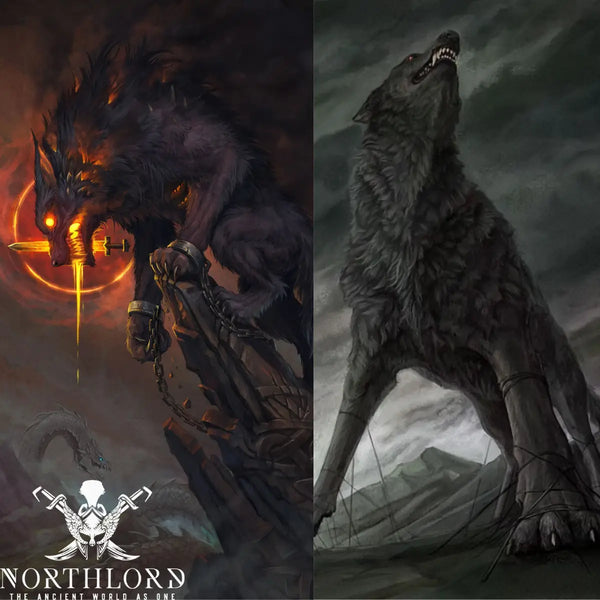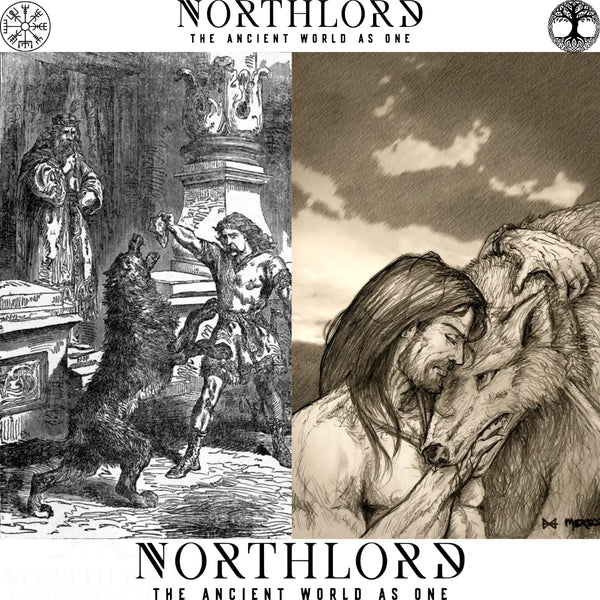Wolves In Norse Mythology

The Wolf Fenrir
Fenrir or Fenris is the most common name of the legendary monstrous wolf. In several manuscripts of the Viking Age, Fenrir also referred to as Hróðvitnir which translates to “fame wolf” and Vánagandr which means “monster of the river”. The wolf Fenrir is the son of god Loki and the giantess Angrboda who had two more children, Jörmungandr known as “The World Serpent” and the goddess of the Underworld Hel.
When the three children were born, Aesir Gods sensed that great catastrophe and disaster will be caused by the three children, raised in Jötunheimr, the land of the Giants in Norse Mythology. Because of this sense, Odin commanded the Gods to gather the three Giants and when they arrived Odin threw Jörmungandr to the depths of the sea and Hel to Niflheim. For Fenrir, they decided to raise him themselves to control him. Aesir Gods noticed that the Wolf Fenrir was growing very fast along with his divine physical strength. Only the God Tyr dared to approach Fenrir and feed him. It is said that when Fenrir opened his mouth, his jaws touched the Heaven and the Earth. Fenrir’s nature is known as “Jotun” or “Jotnar” who were the old Norse Giants. They live in Jotunheim and they are a race of fearsome and powerful supernatural entities. The deities Skaldi and Gerd also belong to the Jotun Tribe.

The Binding Of Fenrir – Fenrir and Tyr
Tyr, the God of War and Justice was the most courageous and honest of all Norse Gods and he was the one who raised Fenrir and took care of him. Tyr fed the monstrous wolf every day until he reaches an unspeakable size, causing nervousness and anxiety to the Aesir Gods. The Gods quickly realized that Fenrir would be unbeatable in case of turning against them and they came up with a plan to prevent the obvious outcome.
The Aesir Gods decided to create the strongest fetter to enchain Fenrir. They came up with a heavy iron chain called Leyding and asked Fenrir to try his strength on the fetter. Fenrir allows them to bind him and with one single kick liberated himself from the fetter. The second fetter was twice stronger and its name was Dromi. The monstrous wolf shook himself, knocked the fetter to the ground and kicked it with his feet spreading its pieces to the distance. Norse Gods realized that they will need the strongest fetter ever crafted in order to keep Fenrir chained and controlled. The Aesir went to the dwarfs, the most skilled craftsmen of the Nine Worlds and asked them to forge the strongest fetter ever crafted. The result was Gleipnir, a fetter crafted by the sound of a cat makes when it moves, the beard of a woman, the roots of a mountain, the sinew of a bear, the breath of a fish, and the spittle of a bird. Gleipnir had the appearance of a thin cord in comparison with the previous fetters which appeared heavy and strong. When the Aesir challenged Fenrir to prove his power by breaking Gleipnir, the legendary wolf replied that he would not gain any fame even if he destroys the fetter and asked the Gods to let someone put his hand to his jaws as a pledge that this task will be completed in a good faith. None of the Aesir had the will to put his hand into Fenrir’s mouth and only god Tyr had the courage to do it. The wolf Fenrir struggled to break the magical fetter and the more he struggled the stronger the band grew. That was the moment Fenrir closed his jaws and cut Tyr’s hand from his body.
After the success of the Aesir to keep Fenrir finally chained, they took a cord called Gelgja hanging from Gleipnir, inserted the cord through a large stone slab called Gjöll and fastened the stone slab deep into the ground to ensure that the wolf would never be able to liberate himself. At this moment the wolf Fenrir reacted violently, opened his mouth to bite the gods. The Aesir fought back by stabbing Fenrir’s jaws with a sword. It is said that Fenrir howled horribly and saliva started to run from his mouth forming the river of Van. There, in the river of Van, Fenrir will lie until Ragnarok, the Doom of The Gods.

The Wolf Fenrir During Ragnarok
According to the prophecy, Fenrir would destroy the biggest part of the cosmos during Ragnarok. He will be free again and he will run all over the cosmos with his lower jaw to the earth and his upper jaw to the sky devouring everything in his path. It is also known that Fenrir kills Odin the Allfather and be killed by Odin’s son Víðarr as an act of vengeance.

Fenrir- Poems and Books
The legend of Fenrir inspired poets to mention him in their poetry and a lot of prayers have been written for his existence. A couple of examples are the Poetic Edda and the Prose Edda. In the Poetic Edda, Fenrir is mentioned in three stanzas of the poem Völuspá and in two stanzas of the poem Vafþrúðnismál.
In the Völuspá, is mentioned that Fenrir will devour Odin.
“Then is fulfilled Hlín's
second sorrow,
when Óðinn goes
to fight with the wolf,
and Beli's slayer,
bright, against Surtr.
Then shall Frigg's
sweet friend fall.”
In the Vafþrúðnismál poem, Odin poses a question to the wise jötunn Vafþrúðnir:
"Much I have travelled, much have I tried out,
much have I tested the Powers;
from where will a sun come into the smooth heaven
when Fenrir has assailed this one?"
In the Prose Edda, the Giant wolf is mentioned in these three books, Gylfaginning, Skáldskaparmál and Háttatal.
The Wolf Fenrir In The Modern World
Fenrir’s legend has inspired a lot of artists around the world. Nowadays, we can find his depictions mostly in Viking jewelry but also in historical reconstructions. A lot of craftsmen use Fenrir as decoration on their Viking shields, axes, swords, and drinking horns. In Viking jewelry, Fenrir is a beloved topic finding him depicted in Viking Arm Rings, pendants and necklaces. Back in time, the Vikings used their arm rings to prove their loyalty to their chieftains as well as highlight their wealth and status in the Viking community. Today, Modern Vikings, Heathens, and Pagans wear arm rings and Viking jewelry with depictions of Fenrir to honor him and their ancestors.
Northlord
⚔The Ancient World As One⚔

2 comments
This is a amazing story thank you so much 🐾🌌
Can tell me what all of Loki’s kids are because my dad ordered a bracelet off of Facebook and it was finier and I want to tell him the story but I lost my Norse mythology book through all the moving we’ve had and they’re expensive so can you tell me who all over these kids are just for a little added fun thank you